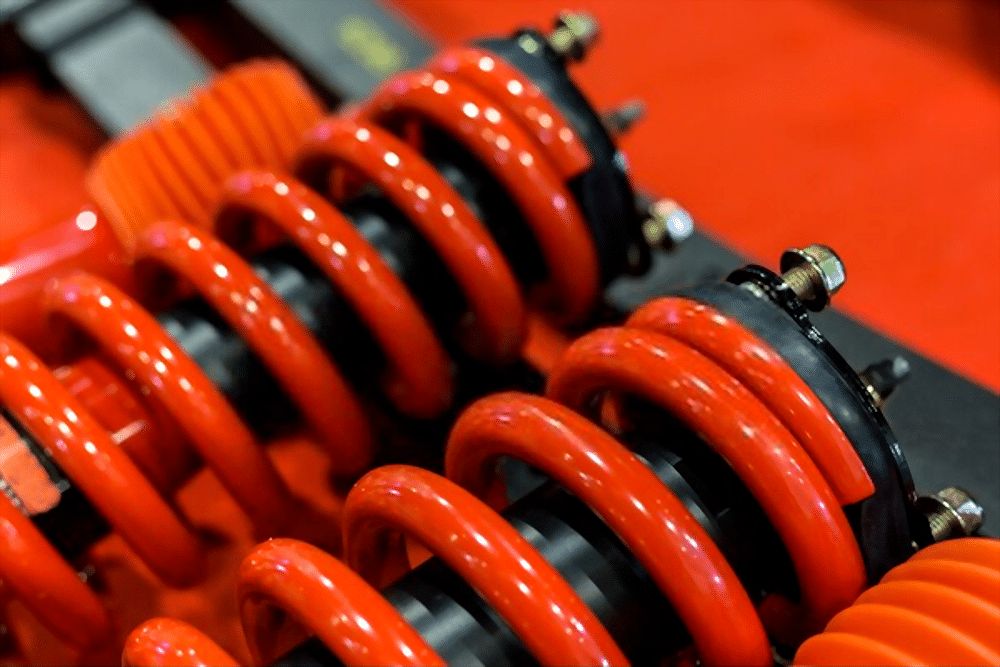Most of you probably know what coilovers are, but not how they work or why they’re considered a worthwhile upgrade over stock suspension. In fact, suspension mods are usually overlooked when it comes to aftermarket upgrades and tuning. A lot of people chase big power numbers with engine upgrades, not thinking about how the chassis is going to cope with all that horsepower. Although coilovers are usually more expensive than your average bolt-on mod like air filters or even cat-back exhausts, they definitely give you the most bang for your buck. They completely transform the way the car drives and feels, making it better both on track and on the street. Let’s go over some of the main talking points regarding coilovers, and then we’ll delve deeper into how they work, as well as answer some common questions and debunk a few myths.
What are Coilovers
A coilover is a complete integrated assembly unit that combines a coil spring and a shock absorber. The coil itself is nested inside a specially-designed shock housing which mounts up in the same place your OEM coil springs (or MacPherson struts) would.
How do coilovers work
To answer this question, we have to look at how struts work, because coilovers are basically struts with a few significant differences. Struts are just shock absorbers which bear part or all of the vehicle’s weight in any given wheel corner. The coil spring, mounted at the top of the strut, compresses and extends as the vehicle hits bumps and dips in the road, allowing the wheel to move freely along the vertical axis.
Coilovers employ a similar setup, but they use a much longer coil spring along with a shock absorber mounted down the length of the coil, so that the coil is technically around (or ‘over) the shock. In order for the wheel to move freely up and down, both the spring and the shock have to extend or compress. The spring itself bears all of the weight and impact force, but it’s the shock absorber’s job to dampen any spring oscillations by converting them to heat.
What are the advantages of coilovers over OEM shocks
The main advantage is the almost infinite amount of adjustability most coilover setups offer compared to traditional shock and spring setups which are fixed. This means that you can pretty much make changes to the car’s handling characteristics without negatively affecting everything else. That’s the main reason why most high-end off-the-shelf stuff you see tends to be coilovers.
Most coilovers come with adjustable ride height, so they’re a great way of lowering your car in addition to making it handle better. I know a lot of you have probably heard about lowering springs, but they’re not a viable alternative to coilovers. The former is just a stiffer, shorter spring that mounts up to your existing suspension. Coilovers are integrated units that completely replace your existing setup.
Are there any downsides or disadvantages to coilovers
The main one is, obviously, the cost. Coilovers don’t necessarily have to cost an arm and a leg, but the general rule of thumb is that the more expensive setups usually work best. Of course, there are exceptions to the rule and not everyone needs a high-end coilover for their car, but you get the idea. Another thing to consider is if you actually need a coilover setup. If you’ve got a decent sports or performance car that already handles relatively well, you might not see much of an improvement on the street. On the track or in the canyons though, they really shine and make the whole car feel that much more alive.
The different types of coilovers
There are two different types of coilovers, the first one being coilover sleeves, often called slip-fit coilovers. They usually fit on top of stock shocks and are considered a slight upgrade to lowering springs, but we don’t recommend using them because they don’t come close to true coilovers and are more expensive than lowering springs.
The second type is full-bodied coilovers, usually called just coilovers because they’re the most common setup. The cheapest coilovers come with adjustable height settings but fixed compression and rebound values. This means that you can change your car’s ride height, but you can’t optimize individual coilover settings for your car or a particular track.
Coilovers that offer adjustable compression and rebound are usually more expensive, but for good reason. They offer an infinite amount of adjustability and can be adapted to any sort of driving or any track.
What are compression and rebound
Compression occurs when the piston head moves into the shock body, compressing the hydraulic fluid inside. This controls the movement of unsprung mass (the weight of components not attached to the car’s body directly, like wheels, tires, rotors, etc.). Rebound on the other hand happens when the piston pulls away and starts returning to its initial position, controlling sprung mass weight (engine, transmission, etc.).
Another thing we haven’t discussed is preload, which is the pressure that’s applied to the spring based on how far it’s compressed in a static position. Preload determines how hard the spring pushes down on the tire and it forces the suspension to work. If you increase compression you’ll reduce the amount of travel the suspension has once the coilover takes on the weight of the car. Preload is useful for optimizing grip, as a tire that’s in contact with the road for longer will effectively yield in more traction.
Different types of springs found in coilovers
When it comes to aftermarket coilovers, the springs they use to make a lot of difference as well. Essentially, there are two types of springs you’ll find on most coilover setups: linear and progressive. A lot of the high-end products use linear springs which provide an equal amount of force distribution for each step of compression. This means that as the coilover gets further into its travel, you get the same amount of dampening. It’s a predictable setup and one which yields the most amount of performance on the track, where predictability is key. They’re also fairly simple and robust. They’re usually stiffer than progressive springs though, so we only recommend them if you’re doing track days often or if you’re going to be installing them on a dedicated weekend car.
Progressive springs, on the other hand, are designed for road use, where compliance and road comfort are needed. These springs are soft at the top of their travel, gradually becoming stiffer and stiffer as they bottom out. If you think about it, that’s exactly what you want from a street-oriented coilover. A setup that’s soft when you’re just cruising, but one that can cope with the added stress and performance once you start pushing hard.
Twin Tube and Monotube
Twin-tube and monotube refer to the coilover design and their architecture. Although the two setups look similar from the outside and can be hard to distinguish even for the trained eye, they’re different when it comes to the way they were built and the way they operate. Most OEM shocks use a twin-tube setup, and so do the majority of low-end and mid-level coilovers. Twin-tube simply means that the entire assembly is made up of two smaller components: an inner and an outer tube. The inner tube houses the piston shaft, the valve, and the oil, while the outer tube holds both the damper oil and the nitrogen gas. This design allows for a lot of suspension stroke without increased body height.
Performance cars and high-end coilovers use a monotube design. Unlike the twin-tube, the monotube has a single tube which houses everything. To separate fluids inside, it has an internal floating piston. On the face of it, this is a much simpler design and one which should be a lot cheaper to manufacture. However, since monotubes use beefier and stronger parts for better heat dissipation and a sharper response, they’re actually more costly than twin tubes (when we’re talking about an apples to apples comparison).

